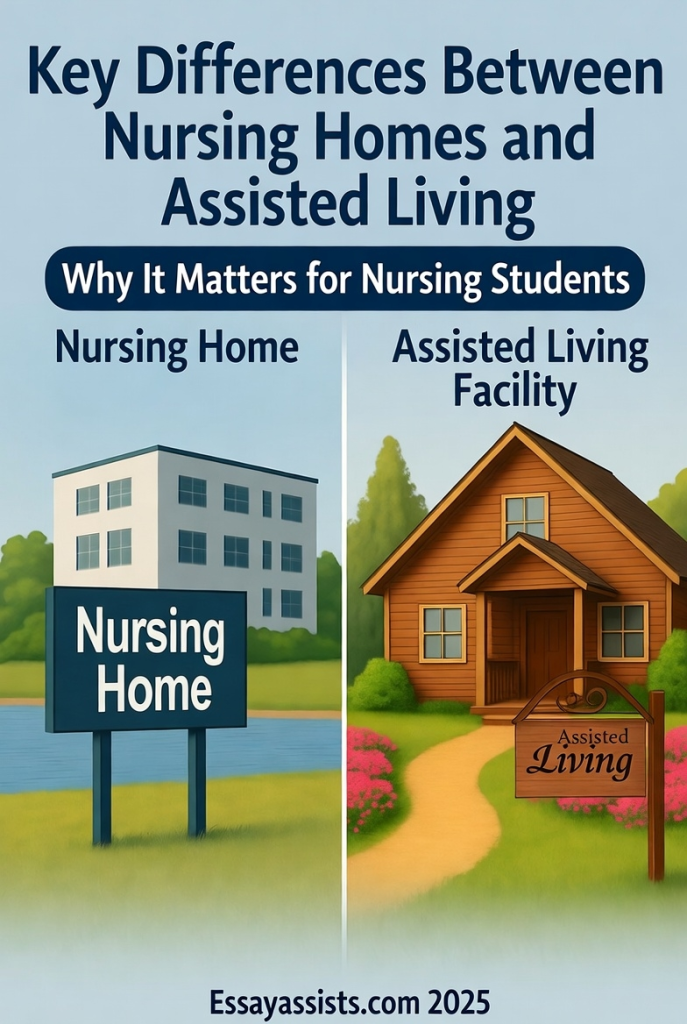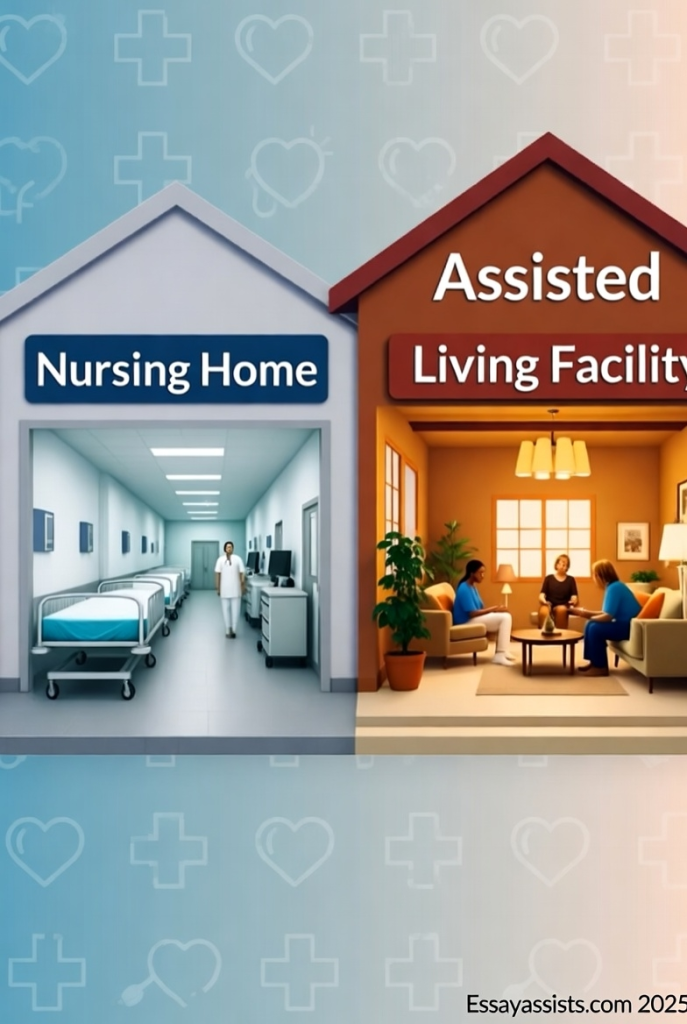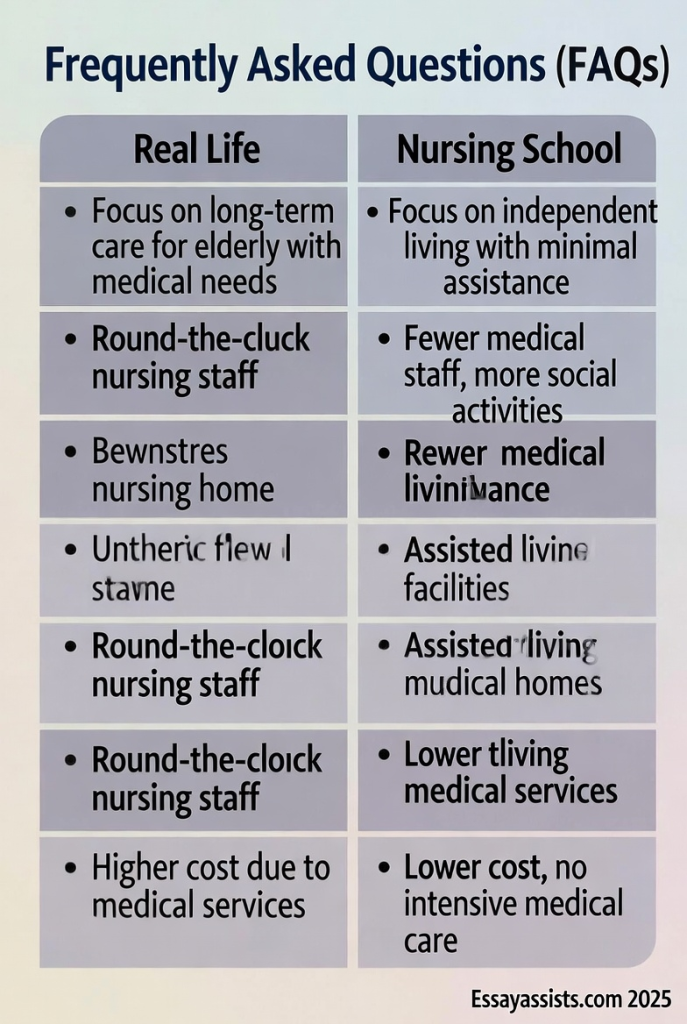
Introduction
Making decisions about elder care is never easy. Families often face the tough choice between nursing homes and assisted living facilities, while nursing students must understand the differences to provide the best patient care. Although these terms are sometimes used interchangeably, they represent distinct levels of support and care. Knowing these differences can impact both the quality of life for residents and clinical outcomes for nurses.
What Is a Nursing Home?
A nursing home, also known as a skilled nursing facility (SNF), is a residential care setting designed for individuals who require round-the-clock medical supervision and assistance with daily living. These facilities cater primarily to older adults or people recovering from serious illnesses, surgeries, or injuries that make it difficult to live independently.
In a nursing home, residents receive continuous care from licensed nurses and certified nursing assistants (CNAs). The focus is not only on meeting physical needs but also on ensuring emotional well-being, safety, and comfort.
Key Services Provided in Nursing Homes
Nursing homes offer a wide range of services that go beyond basic daily assistance. They are structured to provide both medical and personal care in a supportive, safe, and supervised environment. The goal is to ensure residents maintain dignity, comfort, and quality of life while receiving professional healthcare. Below are the key services typically found in nursing homes:
1. 24/7 Skilled Nursing Care
Registered nurses (RNs), licensed practical nurses (LPNs), and certified nursing assistants (CNAs) provide around-the-clock medical supervision. They monitor vital signs, administer medications, change dressings, and respond to emergencies. This level of care is essential for residents with chronic illnesses, post-surgical needs, or complex medical conditions.
2. Rehabilitation and Therapy Services
Most nursing homes include on-site rehabilitation units to help residents recover and regain independence. These may include:
- Physical therapy – to improve strength, mobility, and balance.
- Occupational therapy – to help residents perform daily tasks like dressing or eating.
- Speech therapy – to assist those recovering from strokes or communication disorders.
3. Assistance with Activities of Daily Living (ADLs)
Many residents need help with personal care. Nursing home staff assist with:
- Bathing, grooming, and dressing
- Eating and hydration
- Mobility and toileting
This ensures residents receive respectful, compassionate support for their everyday needs.
4. Medication Management
Administering and monitoring medication is a crucial nursing home service. Licensed nurses ensure that prescriptions are taken correctly and on schedule, reducing the risk of medication errors and adverse reactions.
5. Nutritional and Dietary Support
Residents receive nutritionally balanced meals designed to meet their health conditions, preferences, and cultural backgrounds. Dietitians often collaborate with healthcare providers to manage dietary needs, such as low-sodium or diabetic-friendly menus.
6. Social and Recreational Activities
To enhance emotional well-being, nursing homes organize daily social and recreational programs—including games, music therapy, group exercises, and arts and crafts. These activities encourage interaction and reduce feelings of isolation.
7. Specialized Memory Care
Some nursing homes offer dedicated memory care units for residents with Alzheimer’s or dementia. These areas are secured and staffed by professionals trained in cognitive support, ensuring a safe and structured environment.
8. Palliative and End-of-Life Care
For residents with terminal illnesses, nursing homes often provide compassionate hospice and palliative care, focusing on comfort, pain relief, and emotional support for both patients and families.
Who Needs Nursing Home Care?

Not everyone requires the intensive medical attention that nursing homes provide. However, for individuals with significant health challenges or mobility issues, a nursing home can be the safest and most supportive option. These facilities are designed for people who can no longer live independently or need constant medical and personal assistance to maintain their well-being.
Below are the main groups of individuals who typically benefit from nursing home care:
1. Older Adults with Chronic or Complex Health Conditions
Seniors suffering from long-term illnesses—such as heart disease, diabetes, Parkinson’s, or COPD—often require consistent monitoring, medication management, and ongoing medical intervention. Nursing homes provide the professional care needed to prevent complications and maintain stability.
2. Individuals Recovering from Surgery or Hospitalization
Many patients enter nursing homes for short-term rehabilitation after surgeries, strokes, or injuries. These facilities offer physical therapy, wound care, and skilled nursing to help patients recover and regain independence before returning home.
3. People with Cognitive Impairments (Dementia or Alzheimer’s Disease)
Those living with dementia or Alzheimer’s often need 24-hour supervision to ensure safety and manage symptoms like memory loss, confusion, and wandering. Nursing homes with specialized memory care units provide structured routines, calm environments, and trained staff to meet these unique needs.
4. Individuals with Limited Mobility or Disabilities
Residents who struggle with walking, transferring, or performing daily activities such as bathing, dressing, or eating can receive comprehensive mobility support from trained caregivers in nursing homes.
5. Those Requiring Palliative or End-of-Life Care
Patients with terminal illnesses or severe pain can receive palliative or hospice care in nursing homes. These services prioritize comfort, pain management, and emotional support for both the patient and their loved ones.
6. Seniors Without Adequate Family Support
For some elderly individuals, living at home may no longer be safe or practical—especially if they lack family members nearby to assist with daily care. Nursing homes ensure they have access to consistent supervision, social engagement, and medical attention.
In short, nursing home care is ideal for individuals who need continuous medical oversight, skilled nursing, and assistance with daily living. For nursing students, recognizing these patient categories is crucial in developing clinical judgment, understanding geriatric care needs, and planning appropriate interventions.
Why It Matters for Nursing Students

Understanding nursing home care isn’t just about memorizing definitions—it’s about recognizing how this knowledge shapes real-world nursing practice. For nursing students, learning the dynamics of nursing home environments provides critical insights into geriatric care, long-term patient management, and the emotional dimensions of healthcare. These experiences serve as a foundation for developing empathy, clinical judgment, and professional competence.
Here’s why understanding nursing homes truly matters in nursing education and practice:
1. Builds Strong Geriatric Nursing Skills
A large portion of nursing involves caring for older adults. In nursing homes, students gain hands-on experience with age-related health issues such as dementia, diabetes, arthritis, and heart disease. This exposure strengthens their ability to assess, monitor, and manage chronic conditions with confidence and compassion.
2. Enhances Clinical Decision-Making
Nursing homes are ideal learning environments for developing critical thinking and problem-solving. Students must evaluate patient needs, observe subtle health changes, and make informed decisions—skills that are vital across all healthcare settings.
3. Encourages Compassionate, Patient-Centered Care
Working closely with long-term residents helps students appreciate the importance of dignity, respect, and communication. They learn that effective nursing care is not only about medical intervention but also about emotional support, active listening, and building trust with patients and families.
4. Promotes Interdisciplinary Collaboration
In nursing homes, students interact with a range of professionals—physicians, physical therapists, social workers, dietitians, and caregivers. This collaboration teaches them how to coordinate care effectively, advocate for patients, and function as part of a healthcare team.
5. Provides Real-World Experience with Documentation and Policy
Students also become familiar with healthcare documentation, safety standards, and ethical policies, gaining practical insight into how regulations like HIPAA or infection control protocols apply in long-term care settings.
6. Fosters Emotional Intelligence and Resilience
Caring for elderly residents, especially those facing terminal conditions, helps students develop emotional strength and empathy. They learn to balance professionalism with compassion, an essential trait for long-term success in nursing.
In essence, nursing homes are living classrooms where students can practice both the science and art of nursing. By understanding the complexity and humanity behind long-term care, nursing students emerge as more confident, capable, and compassionate healthcare professionals—ready to provide holistic care in any setting.
What Is Assisted Living?
Assisted living is a type of residential care designed for older adults who value independence but need some help with daily activities such as bathing, dressing, medication management, or meal preparation. It bridges the gap between living at home independently and receiving full-time care in a nursing home. The goal of assisted living is to provide a safe, comfortable, and socially engaging environment where residents can maintain autonomy while having access to the support they need.
Unlike nursing homes, assisted living facilities focus less on medical care and more on personal assistance and quality of life. Residents typically live in private or semi-private apartments, with communal spaces for dining, recreation, and social events.
Key Features of Assisted Living Facilities:
- Personalized Support:
Each resident receives a customized care plan based on their individual needs. Staff provide assistance with tasks like grooming, bathing, and medication reminders while encouraging independence. - 24-Hour Staff Availability:
Although medical staff may not be on-site full-time, trained caregivers and nurses are available around the clock for emergencies or health concerns. - Medication Assistance:
Assisted living staff ensure residents take prescribed medications on time and monitor for potential side effects or complications. - Meal Services and Nutrition:
Residents enjoy nutritious, chef-prepared meals tailored to their dietary needs, often served in shared dining rooms to promote social interaction. - Housekeeping and Laundry:
Regular cleaning and laundry services allow residents to focus on enjoying their daily lives rather than worrying about chores. - Social and Recreational Activities:
Assisted living facilities prioritize engagement and community. Activities such as fitness classes, movie nights, arts and crafts, and group outings help residents stay active, connected, and mentally stimulated. - Transportation Services:
Scheduled transportation is often available for doctor appointments, shopping trips, and recreational outings, ensuring residents remain mobile and involved in the community.
Who Benefits from Assisted Living?
Assisted living is ideal for seniors who:
- Need some help with daily activities but not intensive medical care
- Want to maintain independence in a social and safe setting
- Experience mild mobility issues or cognitive decline
- Prefer a community lifestyle rather than living alone
Why It Matters for Nursing Students
For nursing students, understanding assisted living environments helps them appreciate the balance between care and independence. These settings emphasize preventive care, patient education, and holistic well-being, giving future nurses insight into the social and emotional aspects of aging. Students learn how to:
- Encourage independence without compromising safety
- Monitor for early signs of health decline
- Build therapeutic relationships centered on respect and empathy
In essence, assisted living represents a person-centered approach to elder care—one that values dignity, community, and support over dependency. For nursing students, it’s a vital learning environment that reinforces the principles of compassionate, individualized care.
Would you like me to move on to the next section — “Key Differences Between Nursing Homes and Assisted Living”?
Key Differences Between Nursing Homes and Assisted Living

| Feature | Nursing Home | Assisted Living |
| Medical Care | 24/7, including skilled nursing | Limited, usually with periodic check-ins |
| Independence | Low, residents need constant support | Higher, residents manage some daily tasks |
| Staff | Registered nurses, licensed practical nurses, CNAs | Caregivers, sometimes with part-time nursing support |
| Cost | Generally higher due to intensive care | Often lower, with more flexibility in services |
| Typical Residents | Chronic illnesses, post-surgical rehab, dementia care | Seniors needing occasional help with ADLs |
Why It Matters in Real Life
Choosing between a nursing home and an assisted living facility is more than just a logistical or financial decision—it’s a life-changing choice that affects an individual’s health, happiness, and overall well-being. Understanding the difference ensures that older adults receive the right level of care, in the right environment, at the right time.
When families select the appropriate care setting, residents thrive physically, mentally, and emotionally. However, a mismatch—such as placing someone who requires skilled medical supervision in assisted living or moving an independent senior into a nursing home—can lead to serious health risks, stress, and decreased quality of life.
To make an informed decision, families should carefully evaluate the following factors:
1. Medical Needs and Chronic Conditions
Determine whether the individual requires 24-hour skilled nursing care or only occasional assistance with medications and daily activities. Someone recovering from surgery or living with chronic illness may benefit from a nursing home, while a senior who needs light support might find assisted living more suitable.
2. Level of Independence
Assess how much help the person needs with tasks like dressing, bathing, or managing medications. Assisted living facilities promote independence with minimal support, whereas nursing homes are better for those who need continuous supervision and medical attention.
3. Emotional and Social Needs
Social connection plays a key role in mental health. Assisted living communities often emphasize social engagement, recreation, and companionship, making them ideal for seniors who value community life. Conversely, nursing homes focus on medical stability, which can be more beneficial for individuals facing cognitive or physical decline.
4. Budget and Insurance Coverage
Cost is another critical factor. Nursing homes are generally more expensive due to skilled medical services, while assisted living facilities tend to offer more flexible pricing based on the level of support provided. Families should also review what their insurance, Medicaid, or long-term care plans cover to avoid unexpected financial strain.
In real life, the right choice between assisted living and nursing home care can mean the difference between thriving and merely surviving. Families who take time to assess needs holistically—considering medical, emotional, and financial aspects—help ensure their loved ones live in a setting that promotes safety, dignity, and comfort.
Why It Matters in Nursing School
For nursing students, understanding the distinction between nursing homes and assisted living facilities goes far beyond theory—it shapes how they approach patient care, empathy, and professional practice. Each setting offers unique learning experiences that help future nurses develop clinical judgment, adaptability, and compassion, all of which are essential for providing high-quality, person-centered care.
Here’s why this knowledge is so important in nursing education:
1. Builds a Foundation in Geriatric and Long-Term Care
As the global population ages, nurses increasingly work with older adults across various healthcare settings. Knowing the difference between assisted living and nursing home care helps students understand the spectrum of aging, from independence to full-time medical support. It also prepares them to assess patient needs accurately and create care plans tailored to each individual’s condition.
2. Enhances Clinical Competence and Decision-Making
In both environments, nursing students learn how to evaluate vital signs, monitor chronic illnesses, and provide daily assistance. The difference lies in the level of intervention—nursing homes require more hands-on clinical care, while assisted living emphasizes observation and preventive health. This balance sharpens students’ ability to think critically and respond appropriately to changing patient conditions.
3. Strengthens Communication and Empathy
Whether in assisted living or nursing homes, students interact closely with residents and families. These experiences teach them to communicate with patience, cultural sensitivity, and empathy, especially when discussing care options, treatment plans, or emotional concerns. Understanding residents’ lifestyles and preferences helps students deliver care that respects autonomy and dignity.
4. Encourages Collaboration and Teamwork
Both care settings require strong interdisciplinary collaboration among nurses, physicians, therapists, social workers, and caregivers. Nursing students learn to function effectively within these teams, advocate for residents’ needs, and coordinate holistic care plans that address physical, emotional, and social well-being.
5. Promotes Ethical Awareness and Professional Growth
Working in long-term care environments exposes students to ethical challenges—such as end-of-life decisions, consent, and patient rights. These real-world scenarios help them develop professional maturity, empathy, and the ability to handle sensitive situations with integrity and compassion.
6. Prepares Students for Diverse Nursing Careers
Experience in both nursing homes and assisted living facilities equips nursing students for varied career paths, including geriatrics, rehabilitation, community health, and hospice care. The skills they develop—assessment, communication, documentation, and emotional intelligence—are transferable to any healthcare setting.
In essence, understanding the difference between nursing homes and assisted living is more than an academic exercise—it’s a critical step in becoming a well-rounded, compassionate nurse. By recognizing how care environments shape patient outcomes, nursing students gain the insight and empathy needed to deliver safe, personalized, and dignified care throughout their professional journey.
Tips for Making the Right Choice

Choosing between a nursing home and an assisted living facility can be one of the most emotional and important decisions a family will ever make. The right choice ensures that your loved one receives appropriate care while maintaining comfort, dignity, and peace of mind. Whether you’re a family caregiver, a healthcare professional, or a nursing student learning about long-term care planning, understanding how to evaluate these options is essential.
Here are some practical, evidence-based tips to help guide the decision-making process:
1. Assess the Level of Care Needed
Start by evaluating your loved one’s medical and personal care requirements.
- If they need 24-hour medical monitoring, rehabilitation, or assistance with multiple activities of daily living (ADLs), a nursing home is more appropriate.
- If they only need occasional support with tasks like medication reminders, bathing, or meal preparation, assisted living may be a better fit.
2. Visit Multiple Facilities in Person
Online reviews and brochures only tell part of the story. Schedule visits to observe:
- Staff-to-resident ratios
- Cleanliness and organization
- Staff friendliness and professionalism
- Resident engagement and atmosphere
Talking directly with staff, residents, and families provides valuable insight into the culture and quality of care.
3. Ask the Right Questions
During your visits, prepare a list of questions such as:
- What medical services are available on-site?
- How are emergencies handled?
- What is included in the monthly fee?
- Are there specialized programs for memory care or rehabilitation?
Clear communication ensures that expectations align with reality.
4. Consider Social and Emotional Well-Being
Don’t overlook the importance of community, social interaction, and mental health. Assisted living communities often promote independence through group activities and social events, while nursing homes may provide structured routines and therapy for those with advanced conditions. Choose the environment that best matches the resident’s emotional needs and personality.
5. Review Costs and Insurance Coverage
Care costs can vary widely.
- Nursing homes tend to be more expensive due to skilled nursing and 24/7 supervision.
- Assisted living offers more flexibility, often charging based on the level of care needed.
Before making a decision, review insurance policies, Medicaid eligibility, or long-term care plans to avoid financial strain.
6. Involve the Resident in the Decision
Whenever possible, include your loved one in discussions. Respecting their preferences fosters a sense of control, dignity, and comfort, making the transition smoother and more emotionally supportive.
7. Think About the Future
Health needs can change over time. Choose a facility that offers progressive care options, so if your loved one’s condition worsens, they can transition smoothly without having to move to a completely new environment.
In summary:
The best choice depends on balancing medical needs, independence, emotional health, and affordability. Taking time to research, visit, and ask questions ensures that your loved one receives care in a setting that promotes safety, respect, and happiness. For nursing students, understanding these decision-making steps offers valuable insight into patient advocacy and family-centered care—skills that are vital in every nursing career.
Conclusion
Understanding the difference between nursing homes and assisted living is crucial both for families making care decisions and for nursing students developing clinical expertise. While nursing homes provide comprehensive medical care for residents with complex needs, assisted living emphasizes independence with support for daily activities. Recognizing these distinctions ensures better care, safer environments, and higher quality of life for seniors. For nursing students, this knowledge translates into practical skills, critical thinking, and empathy—all essential for a successful career in healthcare..
Frequently Asked Questions (FAQs)

Choosing between a nursing home and an assisted living facility often raises many questions for families, caregivers, and nursing students alike. Below are some of the most common questions — and clear, concise answers — to help guide informed decisions.
1. What’s the main difference between a nursing home and assisted living?
The key difference lies in the level of medical care provided.
- Nursing homes offer 24/7 skilled nursing and medical supervision for residents with serious or chronic health issues.
- Assisted living facilities provide personal support and limited medical assistance, focusing on independence and quality of life.
2. How do I know if my loved one needs a nursing home or assisted living?
Assess your loved one’s medical needs, mobility, and daily functioning:
- If they require ongoing medical treatment, frequent nurse supervision, or rehabilitation therapy, a nursing home is likely best.
- If they’re mostly independent but need help with daily activities like bathing or medication reminders, assisted living is more suitable.
3. Are nursing homes more expensive than assisted living?
Generally, yes. Nursing homes are more costly because they provide round-the-clock skilled nursing, therapy, and medical services. Assisted living costs are typically lower and based on the level of personal care required. However, prices vary by location, facility, and insurance coverage.
4. Does insurance or Medicaid cover the cost of care?
In many cases:
- Medicaid may cover nursing home care for eligible individuals.
- Assisted living coverage is more limited, though some states and long-term care insurance plans offer partial support.
It’s important to review the resident’s insurance policies and local Medicaid guidelines before making a decision.
5. Can residents transition from assisted living to a nursing home?
Yes. Many individuals start in assisted living and move to a nursing home as their health needs increase. Some facilities even offer continuum-of-care programs, allowing residents to transition smoothly without leaving the community.
6. What should families look for when visiting a facility?
When touring, pay attention to:
- Cleanliness and safety measures
- Staff friendliness and professionalism
- Resident engagement and happiness
- Meal quality and recreational activities
- Availability of medical or emergency services
7. How do nursing students benefit from understanding these facilities?
For nursing students, learning about nursing homes and assisted living enhances their understanding of elder care, patient advocacy, and multidisciplinary teamwork. It helps them adapt their care approach to fit each environment, ensuring they deliver safe, compassionate, and individualized nursing care.
8. Can assisted living residents receive nursing care if needed?
Yes, but only to a limited extent. Assisted living facilities may offer visiting nurses or part-time medical staff for basic care needs, such as medication management or monitoring chronic conditions. Residents requiring intensive or continuous medical supervision would need to transfer to a nursing home.
9. How can families make the transition easier for loved ones?
To make the move smoother:
- Involve your loved one in the decision-making process.
- Visit the facility together before moving in.
- Personalize their living space with familiar items.
- Maintain regular visits and communication after the transition.
10. What role do nurses play in assisted living versus nursing homes?
- In nursing homes, nurses provide direct medical care, manage medications, and monitor complex conditions.
- In assisted living, nurses act more as health coordinators, focusing on wellness, education, and preventive care.
Understanding these differences ensures families make informed, compassionate choices — and helps nursing students appreciate the diverse responsibilities of nurses across care settings.
Would you like me to wrap up the blog with the Conclusion section next?
